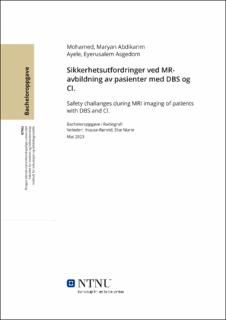| dc.contributor.advisor | Huuse-Røneid Else Marie | |
| dc.contributor.author | Ayele, Eyerusalem Asgedom | |
| dc.contributor.author | Mohamed, Maryan Abdikarim | |
| dc.date.accessioned | 2023-07-20T17:19:44Z | |
| dc.date.available | 2023-07-20T17:19:44Z | |
| dc.date.issued | 2023 | |
| dc.identifier | no.ntnu:inspera:139584812:148961376 | |
| dc.identifier.uri | https://hdl.handle.net/11250/3080560 | |
| dc.description.abstract | Sammendrag
Problemstilling: Hva er sikkerhetsutfordringene ved MR-undersøkelser av pasienter med dyp hjernestimulator og cochlea implantat, og hvordan kan radiografene håndtere potensielle farer for å sikre en trygg MR-undersøkelse for denne pasientgruppen?
Hensikt: Hensikten med denne oppgaven er å se nærmere på MR-sikkerhetsutfordringene ved MR-undersøkelser av pasienter med dyp hjernestimulator (eng. deep brain stimulation, DBS) og cochlea implantat (CI). Deretter skal oppgaven fokusere på hvordan potensielle farene kan håndteres av radiografene.
Metode: En litteraturstudie er benyttet for å løse problemstillingen. Vi analyserer resultatene til åtte studier for å undersøke sikkerhetsutfordringene som oppstår ved MR-avbildning av pasienter med DBS/CI. I tillegg potensielle tiltak som radiografene kan benytte for å gi en trygg undersøkelse.
Resultat: Hovedutfordringene som har blitt funnet ved MR-avbildning med DBS og CI er ulike. Utfordringen er implantatoppvarming og IPG-dysfunksjon. Potensielle tiltak som radiografene kan gjøre er bruk av1.5T magnetfeltstyrke og sender/mottaker hodespole og bruk av spesifikke sekvenser. Ved CI er utfordringene smerte, ubehag og forskyvning av den interne magneten. Potensielle tiltak er bruk av bedøvelse, kunnskap av modell typen til implantatet, bruk av supinert stilling ved plassering av pasienten, passe på magnet polariteten av MR-maskinen og å unngå reposisjonering i magnetåpningen.
Konklusjon: Det finnes MR-tilpasset retningslinjer som er lagt av implantatleverandører for pasienter med DBS/CI. De utfordringene med DBS/CI er implantatoppvarming, IPG-dysfunksjon, smerte, ubehag og forskyvning av den interne magneten. Det er dette radiografene må passe på for å gi en trygg MR-undersøkelse for pasienter med DBS/CI. For å oppnå en sikker MR-avbildning av pasienter med DBS/CI har oppgaven kommet frem med noen tiltak hvor avbildnings parametere må tas i betraktning for de ulike utfordringene. Dette gjør det mulig for pasienter med DBS/CI å få diagnostisk nytte av MR på likt nivå som vanlige pasienter gjør. Likevel er det alltid viktig å veie fordeler og ulemper ved diagnostiske undersøkelser. Hvis MR sannsynligvis vil gi betydelige fordeler for pasienter med DBS/CI kan en viss grad av risiko være akseptabel.
Det er ikke mulig å komme fram til et generelt tiltak for DBS/CI, fordi pasienter er implantert med ulike implantatmodeller, hvor noen pasienter har eldre og moderne. Det er krav med flere forskinger for DBD/CI for å få nye oppdaterte kunnskap om de ulike DBS/CI modeller.
Nøkkelord: Magnetisk resonans, dyp hjernestimulator, cochlea implantat, pasientsikkerhet
Antall ord: 7982 | |
| dc.description.abstract | Abstract
Thesis: What are the safety challenges in MRI examination of patients with deep brain stimulator (DBS) and cochlear implant (CI), and how can radiographers manage potential dangers to ensure a safe MRI examination for this patient group?
Purpose: The purpose of this thesis is to take a closer look at the MRI safety challenges in MRI examinations of patients with DBS and CI. The task will then focus on how potential dangers can be handled by radiographers.
Method: A literature review has been used to answer the thesis question. We analyzed the results of eight studies for the safety challenges arising from MR imaging of patients with DBS/CI. In addition, potential measure radiographers can use to provide a safe examination.
Results: The main challenges that have been found in MR imaging with DBS and CI are different. The DBS challenges are implant heating and IPG-dysfunction. Potential measures radiographers can take are use of 1.5T magnetic field strength, head-transmit coils and the use of specific imaging parameters. With CI, the challenges are pain, discomfort, and displacement of the internal magnet. Potential measures include usage of anesthetic, knowledge of the model type of the implant, supine positioning of patient when getting into position, being aware of the magnet polarity of the scanner and avoiding reposition in the bore of the scanner.
Conclusion: There are MRI-conditional guidelines made by implant manufacturers for patients with DBS an CI. The challenges with DBS/CI er implant heating, IPG-dysfunction, pain, discomfort, and displacement of internal magnet. This is what radiographers must be aware of to achieve safe MR imaging of patients with DBS/CI. In order to achieve safe MR examination of these patients, image acquisition parameters can be taken into consideration for the challenges. This makes it possible for patients with DBS/CI to benefit from MRI at the same level as normal patients. Nevertheless, it is always important to weigh the advantages and disadvantages of a diagnostic examination. If MRI is likely to provide significant benefits to patients with DBS/CI, some degree of risk may be acceptable.
It is not possible to arrive at a general safety measure for DBS/CI, because patients are implanted with different implant models of different manufacture years. Some patients have older, and some have more modern devices. More research should be carried out for DBS/CI patients, to gain new and updated knowledge about various DBS/CI models.
Keywords: Magnetic resonance imaging, deep brain stimulation, cochlear implant, patient safety.
Number of words: 7982 | |
| dc.language | nob | |
| dc.publisher | NTNU | |
| dc.title | Sikkerhetsutfordringer ved MR-avbildning av pasienter med DBS og CI | |
| dc.type | Bachelor thesis | |
